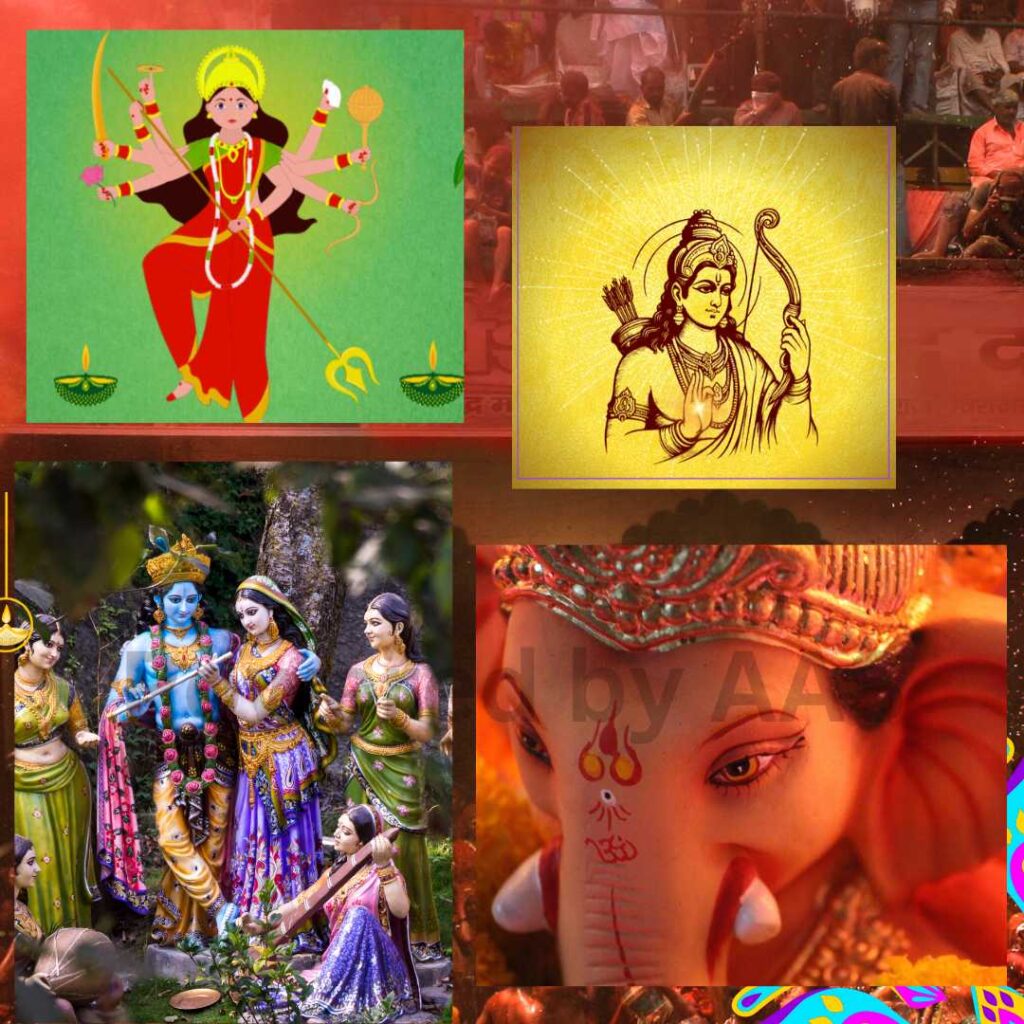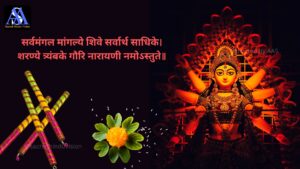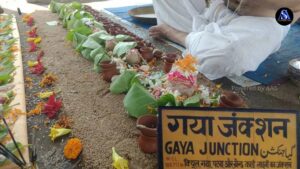Table of Contents
Toggle
Hello friends, I welcome you to our website. Today we will talk about the ten major festivals of Hinduism, each with its own special significance. We will learn why these festivals are celebrated, their history, and how they are celebrated in India. So, let’s start this interesting journey.
The festival of Lights – Diwali (दीपों का त्यौहार – दिवाली)
Diwali, also known as Deepawali, is a major and very popular festival in Indian culture. This festival is celebrated on the night of the new moon, which usually occurs in October or November. The festival of Diwali lasts for five days, during which various customs are followed from Dhanteras to Bhai Dooj. The main attraction of this festival is the lighting of lamps, hence it is also called the ‘Festival of Lights’. On Diwali, people decorate their homes with diyas, candles, and electric lights.
This festival is celebrated in joy of Lord Rama’s return to Ayodhya. According to Hindu mythology, after his 14-year exile with his wife Sita and brother Lakshman. The day also holds special significance for Lakshmi Puja, as it is believed that Goddess Lakshmi visits homes and brings prosperity and happiness on the night of Diwali. Hence, homes are kept clean and attractive.
On Diwali, people wear new clothes and prepare special dishes and sweets. Fireworks are also an exciting tradition of the festival. Children and adults both express their happiness through fireworks. Thus, Diwali not only symbolizes the victory of light over darkness but also provides an opportunity for social harmony and reunion. Diwali teaches us how we should promote positivity in our lives and move towards light by dispelling darkness.

The festival of Colours – Holi (रंगों का त्यौहार – होली)
Holi is one of the most diverse and colorful festivals of Indian culture. This festival symbolizes the arrival of spring and is also known as the ‘Festival of Colors’. Holi is celebrated on the full moon day of the Phalguna month, which occurs in March.
The festival begins with Holika Dahan, where people light a fire by stacking wood, known as ‘Chita’. The ritual of Holika Dahan is connected with the story of Prahlad and Hiranyakashyap, where Prahlad’s devotion saved him from fire and Holika, who was granted immunity from fire, herself got burned. Through this event, Holi conveys the message of victory of good over evil. The next day, known as ‘Rangwali Holi’, people throw colors and gulal at each other. This day symbolizes joy and unity, where people forget social bonds and class distinctions and celebrate together.
Special sweets made during Holi include gujiya, malpua, and thandai, which double the joy of the festival. During this festival, various cultural programs are also organized, including music, dance, and drama. Holi is celebrated not just in India but around the world by the Indian diaspora with great enthusiasm. Holi teaches us how we should embrace diversity in our lives like colors and fill every moment with joy.

The festival of Victory – Dussehra (विजय का त्यौहार – दशहरा)
Dussehra, also known as Vijayadashami, is one of the most important festivals of Indian culture. This festival is celebrated in the Hindu month of Ashwin, which typically falls in September or October. Dussehra is a symbol of the victory of good over evil. The main story associated with this festival is Lord Rama’s victory over Ravana. According to the Ramayana, Rama launched an invasion of Lanka to rescue his wife Sita from Ravana’s captivity. On the day of Vijayadashami, Rama defeated Ravana, which is celebrated as Dussehra. This day is also celebrated as a weapon worship day, where weapons of war are worshipped. This practice is especially prevalent among the Kshatriya community in India.
On Dussehra, many places host Ramlila, which enacts various scenes from the Ramayana. The most attractive event of this festival is the burning of effigies of Ravana. These effigies are usually large and made of bamboo, paper, and firecrackers. At the time of the effigy burning, people enjoy fireworks and celebrate it as a major social and cultural festival. Dussehra is also considered a sign of new beginnings, especially for educational and business ventures. Many people start new businesses or educational-related activities on this day. Thus, Dussehra not only reminds us of the victory of good over evil but also motivates us to move forward in life with new hopes and towards our goals.

The Festival of Lord Krishna – Janmashtami (कृष्ण पक्ष की अष्टमी का त्यौहार – जन्माष्टमी)
Janmashtami is a major festival in Hinduism celebrating the birth of Lord Krishna, celebrated across India with special reverence and enthusiasm. This festival falls on the eighth day of the Krishna Paksha in the month of Bhadrapad, usually in August or September. This day is celebrated as the birthday of Lord Krishna, who was born at midnight. On this occasion, idols of Lord Krishna in temples and homes are bathed and dressed in new clothes and specially decorated.
Devotees fast and stay up all night worshipping Lord Krishna. After the midnight birth, a special Aarti is performed, and various offerings are made to Lord Krishna. On Janmashtami, temples and homes organize hymn and chant sessions, and songs about Krishna’s exploits are sung. Many places also set up tableaux that depict various episodes from Krishna’s childhood. The tableau of baby Krishna is especially popular on this day. At night on Janmashtami, the ‘Dahi Handi’ event is also organized, where groups of young people form a human pyramid to break a pot of yogurt hung at a height. This symbolizes Lord Krishna’s playful act of stealing butter with his friends.
During the festival, various types of prasad are prepared, including panjiri, kheer, and mishri. Janmashtami is celebrated not only in India but also around the world by Krishna devotees with great joy. The festival reminds us of Lord Krishna’s life and his messages, and it conveys a message of unity and love.

The Festival of Maa Durga – Navratri (माँ दुर्गा का त्यौहार – नवरात्रि)
Navratri, which means ‘nine nights’, is one of the most important and grand festivals of Hinduism. This festival is specifically dedicated to the worship of Goddess Durga and is celebrated in different ways across India. Navratri is celebrated twice a year, once in the month of Chaitra (March-April) and again in Ashwin (September-October). During Navratri, devotees fast for nine days, perform rituals to worship Goddess Durga, and pay homage to her various forms. Each day is dedicated to a particular form of the goddess. The first three days are dedicated to Goddess Durga, the next three days to Goddess Lakshmi, and the last three days to Goddess Saraswati.
During this period, idols of the goddess are installed in homes and temples, and special Aarti, hymns, and chants are performed. Navratri nights are also famous for Garba and Dandiya Raas dances, especially in Gujarat, where people dressed in traditional attire dance throughout the night. The Navratri of Ashwin month ends with Vijayadashami or Dussehra, which symbolizes the victory of good over evil. On this day, Ramlila is performed, and effigies of Ravana are burned. Thus, Navratri holds not only religious significance but also showcases social harmony and cultural heritage. The festival brings people together and spreads messages of unity and happiness in society.
Friends, these were some of the major Hindu festivals that not only provide us an opportunity to strengthen our bonds but also allow us to understand the deeper meanings of our culture. I hope you liked this content. If you enjoyed this blog, please like it, share it, and let us know your thoughts in the comments. Don’t forget to visit our website for more new interesting blogs.
Thank you.
जय श्री राम।।
Please Share Through Various Platforms.
Sharad Purnima – Revolutionary Rituals & its importance
या देवी सर्वभूतेषु शक्ति-रूपेण संस्थिता।नमस्तस्यै नमस्तस्यै नमस्तस्यै नमो नमः॥ i.e., “Salutations again and again to the Divine Goddess who dwells in all beings in the form of power (Shakti).” Hello friends. Welcome to our Website. This blog is going to be a sensation for everyone thinkers definitely. In this blog, we will talk about The Great Iron Man: – Sardar Vallabhbhai Patel & his thoughts and actions for Hindus & Hindu visions. In the vast
Durga Puja: Mahashaptmi Significance, Rituals, and Spiritual
या देवी सर्वभूतेषु शक्ति-रूपेण संस्थिता।नमस्तस्यै नमस्तस्यै नमस्तस्यै नमो नमः॥ i.e., “Salutations again and again to the Divine Goddess who dwells in all beings in the form of power (Shakti).” Hello friends. Welcome to our Website. As the warm colors of autumn mix with the sweet smell of shiuli flowers and the lively beats of dhak drums, Durga Puja 2025 begins on Mahashashthi, which is September 28. This five-day event is full of deep devotion, beautiful

“Navaratri: A Pivotal Tour of Inner Power and Divine Triumph”
या देवी सर्वभूतेषु शक्ति-रूपेण संस्थिता।नमस्तस्यै नमस्तस्यै नमस्तस्यै नमो नमः॥ i.e., “Salutations again and again to the Divine Goddess who dwells in all beings in the form of power (Shakti).” Hello friends. Welcome to our Website. Today we will discuss a topic i.e., Navratri: A Vibrant Nine-Day Festival of Devotion, Dance, and Divine Power. Navratri, meaning “nine nights” in Sanskrit (“nava” for nine, “ratri” for nights), is one of India’s most colorful and spiritually significant Hindu

Mahalaya Amavasya: A Sacred and Spiritual Festival – 02
Mahalaya Amavasya is a sacred Hindu observance marking the end of Pitru Paksha—a period dedicated to honoring ancestors through rituals like shraddha and tarpan. Families across India pay homage to departed souls, seeking their blessings and peace. This day not only upholds the tradition of expressing gratitude to ancestors but also heralds the onset of Devi Paksha and Durga Puja celebrations. Mahalaya Amavasya stands as a beautiful blend of remembrance, spiritual reflection, and the renewal of hope, emphasizing the eternal bond between generations and the cyclical nature of life itself.

महालय अमावस्या: एक पावन और आध्यात्मिक पर्व
ॐ पितृभ्यो नमः।श्रद्धया पितॄन् स्मरामि विश्वपितॄन् च सर्वशः।तेषां पुण्यकृतां देवानां च पितॄणां च वयं नमामः। i.e., Om salutations to the ancestors.With reverence, I remember the ancestors, the universal forefathers who are virtuous gods.To them, the holy ones and the ancestors, we offer our salutations. नमस्कार दोस्तों! स्वागत है आपका हमारे चैनल पर। महालय अमावस्या का यह शुभ अवसर हमारे बीच एक बार फिर उपस्थित हुआ है। यह दिन हिन्दू पंचांग के अनुसार पितृ पक्ष का

Hindutva: The Ultimate Political Empowerment of Culture – 02
नमस्ते सदा वत्सले मातृभूमे त्वया हिन्दुभूमे सुखं वर्धितोहम्।महामङ्गले पुण्यभूमे त्वदर्थे पतत्वेष कायो नमस्ते नमस्ते॥ i.e., O loving Motherland, I always salute you! On this Hindu land, I have grown up happily with your nurture and care. O most auspicious and sacred land, for your sake I offer this mortal body. I bow to you again and again.. Hello friends! Welcome to our Website. Today we will discuss a topic that has deeply influenced Indian politics:

Celebrating Major Hindu Festivals and Their Significance
Celebrating Major Hindu Festivals and Their Significance (हिन्दू धर्म के प्रमुख त्यौहारों का उत्सव और उनका महत्व) Hello friends, I welcome you to our website. Today we will talk about the ten major festivals of Hinduism, each with its own special significance. We will learn why these festivals are celebrated, their history, and how they are celebrated in India. So, let’s start this interesting journey. The festival of Lights – Diwali (दीपों का त्यौहार –



